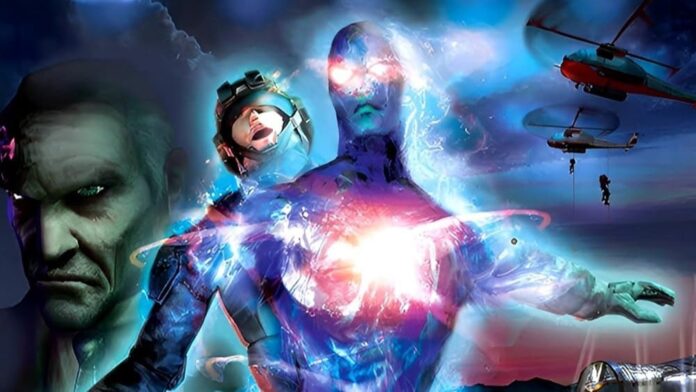Everyone, we like to believe, has a made a secret list for every single console they’ve ever owned, of weird and/or experimental stuff they either want to, or wished they had, played. Sometimes you get round to them, sometimes you don’t. You know the sort of thing. For me, on GameCube specifically, things like Cubivore come to mind, and to a lesser extent Eternal Darkness and Geist. Yes, Geist! Which means “ghost” in German. Did you know that? Of course you did. Every Geisterjäger or Paranormal-Forscher worth their salz knows this stuff.
Now, Geist didn’t exactly set the world on fire when it came out, but to skip over it for its shortcomings — of which it has its fair share — is to do yourself out of a genuinely odd, unsettling and actually quite good game. And, you know what, 20 years down the line from when it originally released, it’s perhaps more intriguing than ever thanks to how differently it plays compared to many of its peers.
Also, Nintendo, you folks should just put it on the Switch 2, because its biggest issue was performance, and that’ll sort it. Done and dusted.
Geist was originally released on 15th August 2005 in the US, and was developed by n-Space and published by the Big-N itself. In fact, it had the honour of being only the second M-rated game that Nintendo had published for the GameCube — I mentioned the first above (Eternal Darkness). In the game, you play as John Raimi, a boffin who’s also a member of the counter-terrorist tactical team known as CR-2.
When a rescue goes wrong at the outset of the adventure, and a whole bunch of people die in various paranormal ways (so like a standard Tuesday night in Glasgow, basically), Raimi finds himself…well, dead, so he’s a ghost now, isn’t he? So, he’s sort of dead. He has become Geist. And this is where it gets interesting, because being a ghost in a video game is exactly the sort of thing we want to spend our time doing; here, n-Space served up something that dared to be a wee bit unique. Now that’s terrifying.
Even now, playing the opening of this game treats you to action set-pieces that look good in a sort of chunky-first Halo-esque way. With how badly games of this vintage tend to age in terms of visuals, I still think Geist is a bit of a looker, all things considered, and it gets underway with some nice explosions, possessions and all manner of Spooky Things™ down at the old Volks institute – where experiments of the supernatural kind are happening.
Luckily, Geist doesn’t just go with big explosions and shooting things, or else we wouldn’t be talking about it. N-Space decided to consider how, as a ghost, you can do many more interesting things, like possess objects and other characters in the environments which you need to puzzle through, to give us a clever and absorbing game in terms of its mechanics.
That’s not to say there isn’t any shooting at all — there’s a decent amount of pew-pew here, and even some decent boss scraps along the way. Indeed, levels tend to end with a test of your reflexes in this way for the most part, so it’s good the bosses aren’t turgid. But Geist is much more about being a little extra creative. Whether it’s taking control of something like a dog bowl in order to create a diversion, or something a little weirder like possessing a shooting game toy (just so you can then play it), or heck, even soda cans have their uses, it’s a blast, and it gets you thinking a bit.
Human enemies with special abilities or weapons can be targeted so as to make your way past obstacles and environmental puzzles; a grenade goon will enable you to blow stuff up, an engineer will be useful to clear paths and so on. Before you haunt a human, though, you’ll need to scare the bejesus out of them to make them open to the process…so to speak. This is where your loud bangs, noises, and ability to possess beds so you can raise up like a Scooby Doo ghost out of them, comes in handy. The game goes surprisingly deep with this stuff; you can even take out guards by poisoning them, if you know who’s cooking their food.
Add to this the usual gamut of security cameras, computers and things of this nature to take over, and you’ve got a lovely little playground to muck around in, complete with a novel approach to puzzling and a story that, whilst you’re definitely not going to be thinking about it afterwards, does its job in keeping you hooked until the reason behind the entire incident that’s turned you into a floating mischief-maker is unveiled.
If there’s one place where Geist falls down fairly hard, it’s the performance. It’s a clunky old beast overall, and the frame-rate is pretty inconsistent. The controls, too, whilst fine overall, annoy somewhat with a sluggish camera speed with no way to change it!
However, with a fun multiplayer mode that sees up to 4-players engage in three ghost-based modes, and a campaign you can whip through in about seven hours max, Geist is still a game that I look back on with much fondness, and one of those hidden gems that actually lives up to the name. Stick this on without knowing much about it, and 2005 you was in for quite the treat. You still will be today.
Now, go on and put it on NSO so I can get our fancy new GameCube controllers out and start haunting faucets again. Do it.
Did you play Geist back in the day? Have any fond (or not-so-fond) memories of it? Make sure to let us know!

